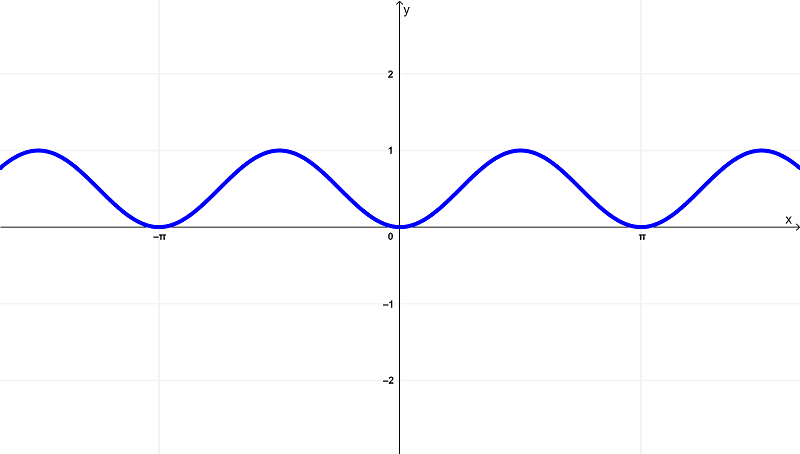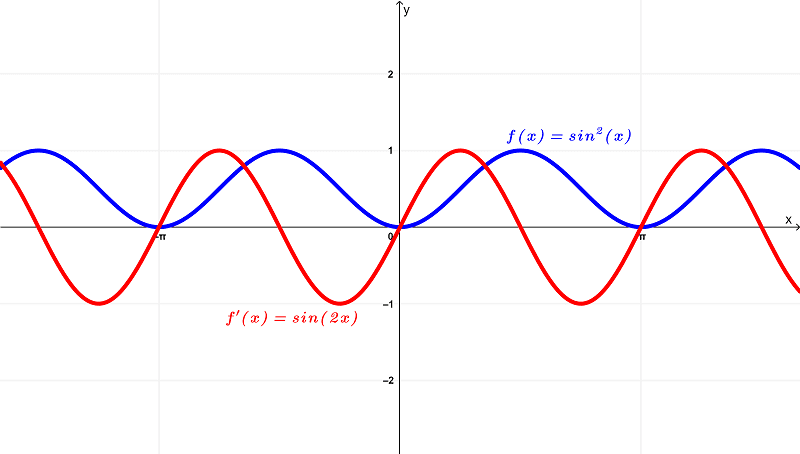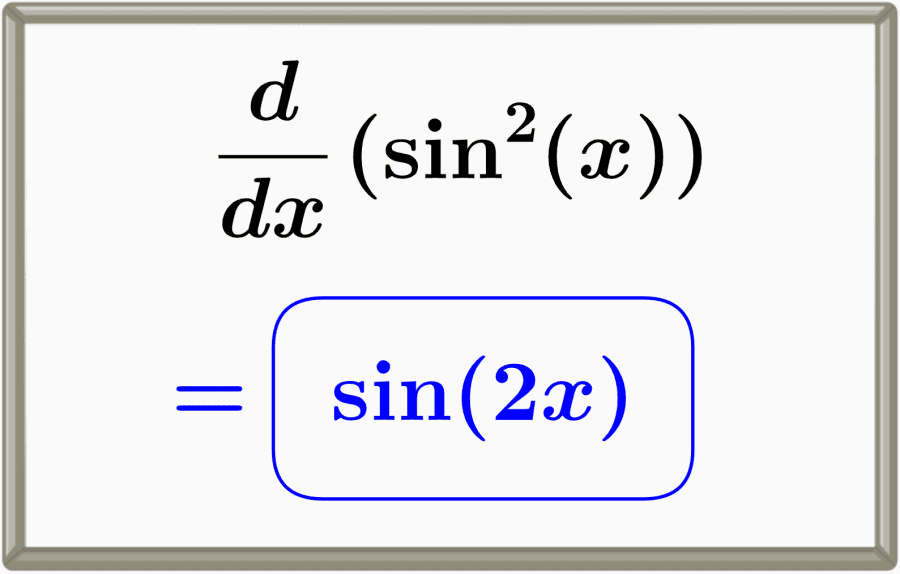The derivative od the sine squared function is equal to sine of 2x, sin(2x). We can find this derivative by using the chain rule and the derivatives of the fundamental trigonometric functions.
In this article, we will learn how to calculate the derivative of the composite function sine squared. We will see a proof, the graphical comparison of sine squared of x and its derivative, and some examples.
Proof of The Derivative of Sine Squared Function Using Chain Rule
If you need it, you are encouraged to review the chain rule formula, as a prerequisite of this topic, by visiting this link: Chain Rule of derivatives. Likewise, you may visit this another link for the proof of the derivative of sine function: Derivative of Sine, sin(x).
Please take note that
$latex \sin^{2}{(x)} \neq \sin{(x^2)}$
Setting confusion aside, the former is a “whole trigonometric function” raised to the power of two, whereas the latter is a trigonometric function of “a variable raised to the power of two.”
Because it is a composite function, the chain rule formula is used to find the derivative formula of sine squared function, provided you have already mastered the the chain rule formula and the derivative of sine function.
Suppose we are asked to get the derivative of
$latex F(x) = \sin^{2}{(x)}$
We can identify the two functions that make up F(x). There is a power function and a trigonometric function in this scenario. Based on our given F(x), they are a function raised to a power of two and a sine trigonometric function.
For easier representation, we can rewrite our given as
$latex F(x) = \sin^{2}{(x)}$
$latex F(x) = (\sin{(x)})^2$
It is evident now that the given power function is the outer function, while the sine function squared by the given power function is the inner function. We can set the outer function as
$latex f(u) = u^2$
where
$latex u = \sin{(x)}$
Setting the trigonometric sine function as the inner function of f(u) by denoting it as g(x), we have
$latex f(u) = f(g(x))$
$latex g(x) = \sin{(x)}$
$latex u = g(x)$
Deriving the outer function f(u) using the power rule in terms of u, we have
$latex f(u) = u^2$
$latex f'(u) = 2u$
Deriving the inner function g(x) using the derivative formula of trigonometric function sine in terms of x, we have
$latex g(x) = \sin{(x)}$
$latex g'(x) = \cos{(x)}$
Algebraically multiplying the derivative of outer function $latex f'(u)$ by the derivative of inner function $latex g'(x)$, we have
$latex \frac{dy}{dx} = f'(u) \cdot g'(x)$
$latex \frac{dy}{dx} = (2u) \cdot (\cos{(x)})$
Substituting u into f'(u), we have
$latex \frac{dy}{dx} = (2(\sin{(x)})) \cdot (\cos{(x)})$
$latex \frac{dy}{dx} = 2\sin{(x)}\cos{(x)}$
Applying the double angle identities, we have
$latex \frac{dy}{dx} = \sin{(2x)}$
This gets us to the sine squared x derivative formula.
$latex \frac{d}{dx} \sin^{2}{(x)} = \sin{(2x)}$
Graph of Sine Squared x VS. The Derivative of Sine Squared x
Given the function
$latex f(x) = \sin^{2}{(x)}$
its graph shows

And as we know by now, by deriving $latex f(x) = \sin^{2}{(x)}$, we get
$latex f'(x) = \sin{(2x)}$
which if graphed, shows

Illustrating both graphs in one, we have

Looking at the differences between these functions based on those graphs, you can see that the original function $latex f(x) = sin^{2}{(x)}$ has a domain of
$latex (-\infty,\infty)$ or all real numbers
and exists within the range of
$latex [0,1]$
whereas the derivative $latex f'(x) = \sin{(2x)}$ has a domain of
$latex (-\infty,\infty)$ or all real numbers
and exists within the range of
$latex [-1,1]$
Examples
In the following examples, we can learn how to derive composite sine square functions.
EXAMPLE 1
Find the derivative of $latex f(x) = \sin^2(6x)$
Solution
We can use the chain rule because we have a composite squared sine function where $latex 6x$ is the inner function.
If we write $latex u=6x$, we have $latex f(u)=\sin^2(u)$. Then, using the chain rule, we have:
$$\frac{dy}{dx}=\frac{dy}{du} \frac{du}{dx}$$
$$\frac{dy}{dx}=\sin(2u) \times 6$$
Substituting $latex u=6x$ back into the function, we have:
$$\frac{dy}{dx}=6\sin(12x)$$
EXAMPLE 2
What is the derivative of $latex F(x) = \sin^2(3x^2-5)$?
Solution
We are going to use the chain rule with the substitution $latex u=2x^2+3$. Therefore, we can write the original function as $latex f (u) = \sin^2(u)$.
Now, let’s find the derivative of the external function:
$$\frac{d}{du} ( \sin^2(u) ) = \sin(2u)$$
Then, we find the derivative of the inner function $latex g(x)$ or $latex u$:
$$\frac{d}{dx}(g(x)) = \frac{d}{dx}(3x^2-5)$$
$$\frac{d}{dx}(g(x)) = 6x$$
To apply the chain rule, we have to multiply the derivative of the outer function $latex f(u)$ by the derivative of the inner function $latex g(x)$:
$$\frac{dy}{dx} = \frac{d}{du} (f(u)) \cdot \frac{d}{dx} (g(x))$$
$$\frac{dy}{dx} = \sin(2u) \cdot 6x$$
Finally, we substitute $latex u=3x^2-5$ and simplify:
$$\frac{dy}{dx} = \sin(2(3x^2-5)) \cdot 6x$$
$$\frac{dy}{dx} = 6x\sin(6x^2-10)$$
Practice of derivatives of sine squared functions


See also
Interested in learning more about the derivatives of trigonometric functions squared? Take a look at these pages:
- Derivative of Cosine Squared, cos^2(x) with Proof and Graphs
- Derivative of Tangent Squared, tan^2(x) with Proof and Graphs
- Derivative of Secant Squared, sec^2(x) with Proof and Graphs
- Derivative of Cosecant Squared, csc^2(x) with Proof and Graphs
- Derivative of Cotangent Squared, cot^2(x) with Proof and Graphs




